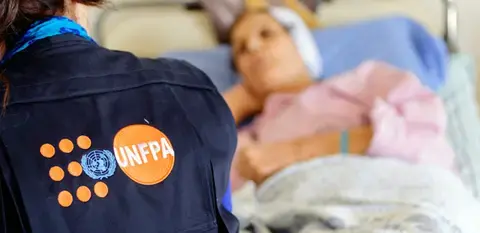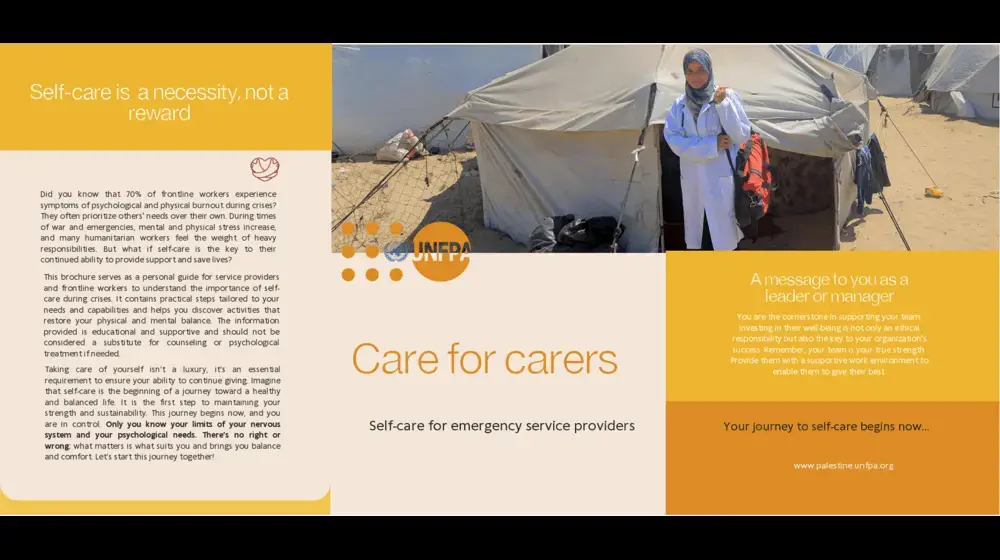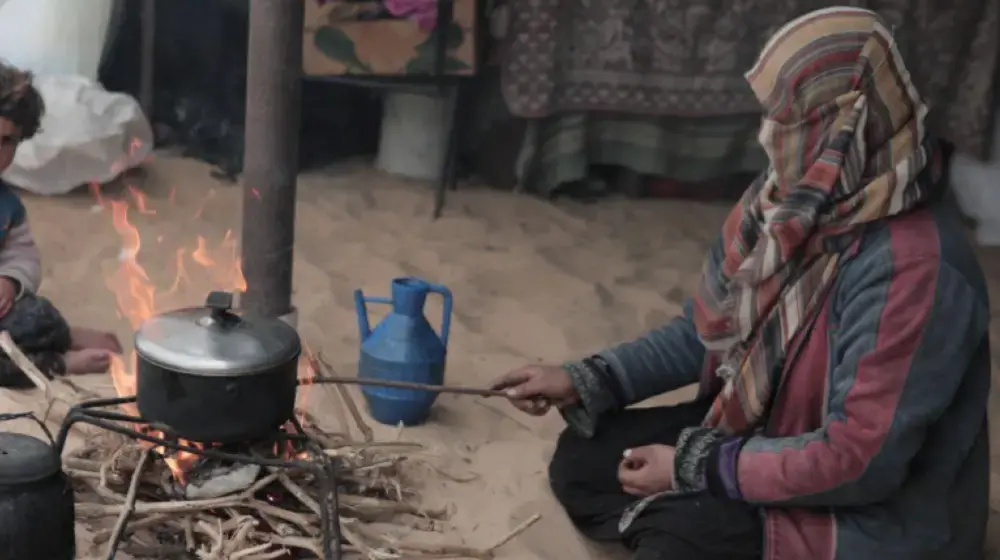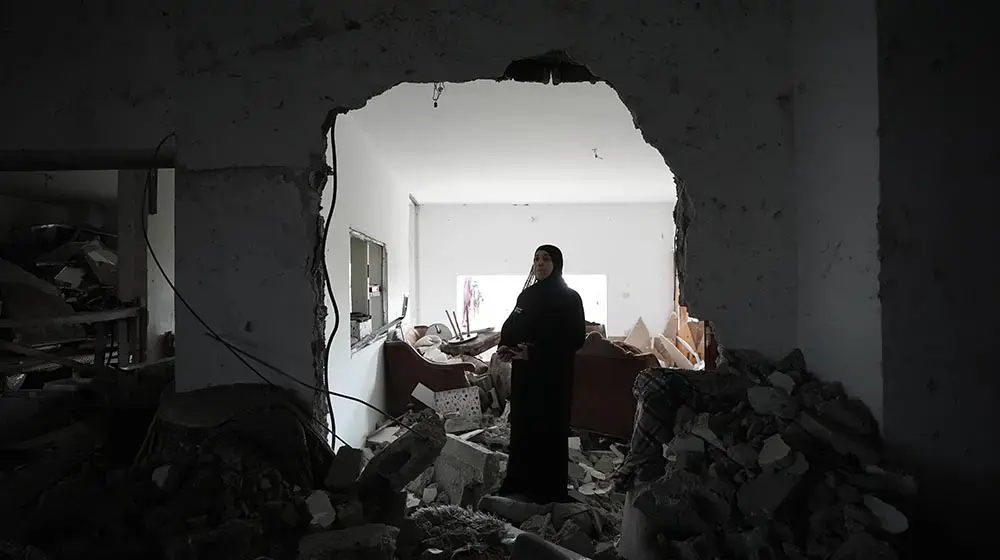Overview:
- According to the Palestinian Central Bureau of Statistics, the Palestinian population in 2016 was 4,816,000 million (2.7935,000 million in the West Bank, including East Jerusalem, and 1.818,000 million in the Gaza Strip).
- The Palestinian population is a young population with 41 per cent below age 15 and almost one third (30 per cent) of the population is aged 15-29 years.
- While the total fertility rate continues to decline; at 3.8 children per woman in 2014, compared to 6 in 1997, it is still one of the highest in the region, and the estimated annual population growth rate is 2.8 per cent. The average age of the population will increase as fertility declines; the proportion of children below 15 is declining while the percentage of working age population aged 15-64 years is increasing.
- Improvement in a number of indicators was achieved during the recent years with the following indicators position Palestine as one of the highest in the region:
| Indicator | Value |
|---|---|
| Coverage with antenatal care | 99.5% |
| Delivery with the assistance of qualified health professional | 99.4% |
| Caesarian section rate | 27.7% |
| Contraception prevalence rate (any method) | 53.4% |
| Contraception prevalence rate (modern method) | 40.8% |
| Coverage with post-natal care | 92% |
| Unmet need for family planning | 10% |
| Practice of breast feeding | 97.6% |
| Practice of exclusive breast feeding | 36.4% |
One of the key achievements at the policy level is UNFPA support to the development of the National Reproductive Health Strategy 2014-2016, which was adopted and endorsed by the Minister of Health. UNFPA is recognized as the sole provider of family planning, while leading an effective role of coordination between service providers to harmonize family planning services, however according to the country programme evaluation, UNFPA need to set an exit strategy and assist MoH for integrating family planning commodities in the annual Ministry of Health budget to ensure sustainability. In 2017, a national effort will be led by the Ministry of Health and supported by UNFPA to update the strategy and align t to national health sector strategy.
Maternal Mortality:
There has been some progress in reproductive health status over the past ten years, Ministry of Health data show that maternal mortality ratio was 38 per 100,000 live births in 2008, falling to 32 in 2011 and to 22 in 2014. Formal figures about maternal mortality ratio are based on surveyed cases of maternal deaths occurring at hospitals and therefore, under-reporting is expected. As of 2008, UNFPA and its national partners developed a national surveillance system for maternal mortality and linked it to mainstream information system of MOH.
Political instability and the recent war on Gaza have been associated with an increase in maternal mortality registered in Gaza in the period 2014-2015.
Review of maternal deaths and ‘near misses’ however identified deficiencies in the quality of care and long-term disabilities resulting from obstetric complications and associated with adequacy and quality of management of key pregnancy-related complications, low compliance with national protocols and lack of adequate medical record keeping and supervision, which hinder the provision of standardized services. Interventions are required to focus on improvement of quality of services, unify and improve case management, institutionalization of supportive supervision and operationalization of accountability systems.
With acknowledgement of quality of care being the lead system associated factors affecting maternal deaths in the country, UNFPA and partners developed ad updated national obstetric care protocols guiding and unifying medical management of obstetric complications
Material and capacity building support provided to MOH maternities in West Bank and Gaza has been vital in remarkable reduction in maternal mortality and improving quality of obstetric care at MOH hospitals.
The programme successfully linked humanitarian to development assistance through implementation of a reproductive health-care model, linking communities with safe delivery points and hospitals in Gaza, allowing women to reach safe delivery and referral stations in crisis and reducing load on central maternities.
Universal coverage:
In general, Palestine enjoys favorable national indicators related to health. The country with intensive network of health service delivery points affiliated to government, non-governmental organizations, UNRWA and private provides reasonable and easy access to basic health services. As a pioneer country, Palestine is prepared to start its journey to achieving universal health coverage in line with SDGs and WHO standards.
High antenatal care coverage in the country reaching 99.5 percent with at least four visits per pregnancy signifies another national indicator positioning Palestine in the lead among countries in the region. Compared with relatively low coverage with post-natal care poses health and human right issue and forms an area for improvement.
Integrity, harmonization and quality of reproductive health services in general remain the major concern at the national level and for all healthcare providers.
High proportion of institutional deliveries, good technical capacity of Palestinian practitioners and overall favorable social conditions have all led to low maternal mortality rates. UNFPA and partners have developed and institutionalized a set of technical and operational guidelines guiding provision of key SRH services and also developed the referral guidelines addressing key at risk conditions and supporting the continuity of care at primary and secondary care levels.
The development of MCH handbook through funding from the Japanese government to GICA has provided a practical tool for care users to monitor the pregnancy and child condition. This tool has a wide use in Palestine and includes a practical one for harmonization of healthcare among different care providers. In spite of large efforts, harmonization and quality of care remain a challenge in Palestine. The new strategic health plan has devoted significant attention to this issue as a mean to rationalize cost and improve quality.
Family Planning:
Contraceptive prevalence rate for all methods is 53.4 per cent, including 40.8 per cent for use of modern contraceptives. However, among the poorest quintile, the contraceptive prevalence rate is only 36%. While the contraceptive prevalence rate has slightly increased during the period 2007-2014, unmet need for family planning demonstrated sharp raise among women from the poorest quintile and among women from remote, isolated and vulnerable communities.
Family health survey in 2010 has shown that high unmet need for family planning was associated with 30% unwanted pregnancies and those demonstrated higher rates of pregnancy-related complications. A UNFPA study in 2013 revealed that unmet need is linked to availability and quality of services, particularly weak counselling, and availability of female provider and in some cases negative providers’ attitude towards family planning. Also, socio-cultural factors related to misconception among women, cultural and religious beliefs, social and economic pressure and influence of husbands, deter women from using contraceptives and is expected to force women for self-abortion or illegal abortion.
Suggested strategies will promote the provision of comprehensive reproductive health services, activation of community-based interventions including male involvement, and enhancement of policy dialogue for client-centred, high-quality, gender-sensitive, accessible and integrated services based on free and informed choice, and in line with the Palestinian needs, priorities, and capacities
HIV/AIDS-STIs:
HIV and AIDS is taking a great toll, resulting in both considerable human suffering as well as economic losses in many parts of the world. Several countries throughout the Middle East region have already been severely affected by the epidemic.
Even though the overall prevalence of HIV in Palestine remains low, the epidemic is by no means under control. Although the Ministry of Health, with support of various international organizations, NGOs and bilateral donors, has made steps in responding to HIV in its early stages, the virus continues to spread and in specific segments of the population transmission is especially prevalent at global, regional levels and could be at national level.
As we know, HIV and AIDS is not just an issue affecting health, but it also has linkages to many other aspects of society and development. Greater social and economic development brings with it many benefits, but it has also made us more vulnerable. Low levels of HIV and AIDS awareness, limited access to comprehensive services, unfavorable social and culture norms, low socio-economic status of women, and high levels of poverty serve to complicate the problem. Moreover, limited capacity and funding at all levels, insufficient engagement across government sectors, limited involvement of the private sector and civil society creates barriers that inhibit expansion of the national HIV and AIDS program.
If the low prevalence of HIV and AIDS is to be maintained over the coming years, fast and comprehensive action is required to effectively address the above mentioned challenges. As outlined in this document, many strategies and approaches have to be reviewed and prioritized in order to increase the effectiveness and impact of the national AIDS program(NHIV strategy 2014).
HIV and AIDS case registration started in 1988 and up to the end of November 2014, 84HIV cases were reported in the national registry (Figure 1), of which 69 developed AIDS with the largest share of registered HIV cases was in the age range 15-49 years.
Midwifery strengthening program:
As of 2016, and with only 2 midwives for each 10000 population, Palestine has a 3000 deficit in midwives to reach international standard. Ratio for physicians stands at and sometimes exceeds international standards for countries in the region excluding Israel. A physician dominated healthcare system in the country limits the space for positioning midwives as the key practitioner and care provider in sexual and reproductive health area.
Through active promotion of midwifery as a health profession and in partnership with national midwifery education institutes and midwifery association, UNFPA and Palestinian Partners succeeded in increasing enrollment in midwifery education from around 45 in 2008 to 90 in 2015.
With the development of unified national curriculum for midwifery at BA level, Palestine has achieved standardization of skills base that midwives possess and this has led to better ability to advocate for positioning of midwives in the health service provision.
Advocacy with health authorities and syndicates is ongoing towards adoption of task shifting and sharing, especially in the area of obstetric care, family planning and counselling. This effort is building on successful examples from the country and globally indicating the capability of midwives to provide safely 80-90% of SRH functions
Quality of midwifery education programs was improved through adoption of 25 e-learning courses for midwives with Palestine being the first country globally to adopt the global e-learning modules.
Strong partnership with IBN SINA College of nursing and midwifery and strong alliance with the nursing and midwifery association resulted in favorable positioning of Palestine at the regional level in the area of midwifery strengthen and education.
In an effort to improve quality of reproductive health care through adoption of task shifting, UNFPA supported a midwife empowerment programme involving care providers and academia. In this regard, a unified midwifery curriculum was developed and adopted; a job profile for midwives was updated to expand their role in healthcare provision. This job profile however was not fully recognized or adopted at the service delivery level. More work at the policy making level is needed to promote and set work force policies to widen the scope of midwifery involvement in reproductive health care provision.
UNFPA has a strong partnership with the Palestinian Nursing and Midwifery Association geared towards strengthening midwives and improve midwifery education and positioning in the health system. Taking this partnership to the higher level, UNFPA county office and the association have been active in the establishment of the regional network of midwifery associations in the Arab World. The network was launched in Casablanca in August 2016 and is currently in the process to apply to the International Confederation of midwives (ICM).
Breast Cancer
Breast cancer is the leading cause of cancer deaths among women. Patient and system delays were measured between 3 to 6 months, leading to the fact that 70% of cases discovered are in the advanced 3rd stage of the disease, making it difficult to treat and resulting in serious physical, psychological and social impairment.
Under generous funding from the government of Japan, and in partnership with Japanese and national governmental and non-governmental organizations, UNFPA is implementing a comprehensive project aiming at improving early detection and quality of life of women living with the cancer.
The project aims at responding to critical issues related to breast cancer, which are manifested by the high contribution of the disease to mortality and morbidity among women.
The project design was geared towards addressing the continuum of care from early detection and diagnosis, treatment and provision of package of rehabilitation and psychological support to women living with the disease.
The women that are detected with cancer and/or surviving the disease face major problems in access to care, especially in Gaza.
In the West Bank, the project supports early detection and diagnosis services in Hebron governorate and works on increasing MOH capacity in early detection and diagnosis. So far the project has been successful in reducing the detection and diagnosis time to levels equivalent to internationally accepted levels (14-21 days).
Procurement of CRs will help MOH meet the needs of population of south West Bank in early detection and the project will also support the procurement of diagnosis equipment to shorten time of diagnosis and allow early referral to treatment.
In Gaza, a network of NGOs works on raising awareness, increasing number of referral to mammography and support women in need with means and resources for transportation to diagnosis and treatment facilities.
Matching with funds provided by WHO, UNFPA is procuring a digital mammography machine to be utilized in Gaza as such technology is lacking.
The progresses of the project show that a developing a comprehensive model including early detection, diagnosis and treatment is possible. Results so far show that sustainability of this intervention within MOH system is also possible.
Youth Health and Reproductive Health
UNFPA has managed to put the Youth Friendly Health Services (YFHS) on the agenda of the Ministry of Health, who agreed to adopt YFHS standards and package in line with WHO standards. In 2014, MoH with support from UNFPA started to offer YFHS in one centre in the West Bank. However, to institutionalize this new model within the system of care, and apply it in other geographic areas i.e. Gaza, policy and advocacy efforts, capacity development of human resources on adolescent and youth health and service provision protocols have yet to be completed.
Peer to peer approach was advanced through strengthening peer to peer educators in schools to deliver messages to their peers on HIV prevention and adolescent health. It is recommended by the Ministry of Education to continue expanding this approach and link with the established national Y-Peer network to promote adolescent sexual and reproductive health, healthy life styles, HIV prevention and gender equality.
- See more at: https://palestine.unfpa.org/sexual-reproductive-health#sthash.rB2jOqci…







